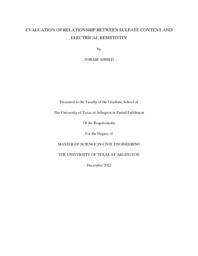
ATTENTION: The works hosted here are being migrated to a new repository that will consolidate resources, improve discoverability, and better show UTA's research impact on the global community. We will update authors as the migration progresses. Please see MavMatrix for more information.
Show simple item record
| dc.contributor.advisor | Hossain, MD Sahadat | |
| dc.creator | Ahmed, Zobair | |
| dc.date.accessioned | 2023-01-26T16:15:18Z | |
| dc.date.available | 2023-01-26T16:15:18Z | |
| dc.date.created | 2022-12 | |
| dc.date.issued | 2022-12-19 | |
| dc.date.submitted | December 2022 | |
| dc.identifier.uri | http://hdl.handle.net/10106/31038 | |
| dc.description.abstract | Texas soils typically have sulfate content due to certain geologic formation types. Soil sulfate needs to be identified and quantified to minimize damage to infrastructure caused by sulfate-induced heave. Electrical Resistivity Imaging can identify the presence of sulfate content in the soil. Electrical Resistivity Imaging (ERI) is a non-destructive and fast way of obtaining continuous soil substructure profiles. Moisture fluctuations and soil heterogeneities can be found using an ERI approach. As a result, ERI is growing in popularity as a tool in geotechnical engineering, yet at the moment, it only offers qualitative data. It can be challenging to determine quantitative geotechnical information about the subsurface from qualitative images, such as the soil type, sulfate content, moisture content, level of saturation, and Atterberg limit.
This study aims to identify the relationship between the soil's electrical resistivity and sulfate content, and geotechnical parameters. Two soil samples from Fort Worth and El Paso were selected for laboratory experimentation. The Fort Worth Sample was high plastic clay, and El Paso was poorly graded sand. Existing sulfate content was measured using a colorimeter for the two soil samples. The laboratory resistivity of these two samples was measured with increasing unit weight and moisture content using Super String IP resistivity equipment. A gypsum solution of 1000 ppm was added and thoroughly mixed with soil to increase the sulfate content of the soil to simulate higher sulfate content. Therefore, sulfate addition of 1000 ppm followed by sulfate testing and resistivity testing was done repeatedly until both samples reached 11000 ppm. Resistivity values were plotted against moisture content (MC), sulfate content (SC), dry unit weight (DUW), void ratio(e), and degree of saturation (DOS) to find out the correlation among the geotechnical parameters of the soil with resistivity. The general trend was downward for MC, SC, DUW and DOS but upward for void ratio. This correlation was used to find suitable parameters for the statistical modeling.
The geotechnical engineering properties of both samples were correlated with electrical resistance using different multiple linear regression (MLR) models developed in R-studio. In developing a multiple regression equation SC, MC, DUW, fine content (FC) was used as an independent parameter. The MLR model was validated based on the laboratory and field test data; therefore, the model can be used for estimating sulfate content. | |
| dc.format.mimetype | application/pdf | |
| dc.language.iso | en_US | |
| dc.subject | Resistivity | |
| dc.subject | Sulfate content | |
| dc.subject | Texas | |
| dc.subject | Fat clay | |
| dc.subject | Sulfate detection | |
| dc.subject | Texas clay | |
| dc.subject | TxDOT project | |
| dc.subject | Sulfate prediction | |
| dc.subject | MLR | |
| dc.subject | Field validation | |
| dc.subject | Moisture content | |
| dc.subject | Lean clay | |
| dc.subject | Poorly graded sand | |
| dc.subject | El Paso clay | |
| dc.subject | Dry unit weight | |
| dc.subject | Fine content | |
| dc.subject | Correlation between resistivity and sulfate content | |
| dc.subject | Quick method to detect sulfate | |
| dc.subject | Faster method | |
| dc.subject | Cheaper Method | |
| dc.subject | 1000 ppm to 11000 ppm | |
| dc.subject | Sulfate addition using gypsum salt | |
| dc.subject | High sulfate content | |
| dc.subject | Low sulfate content | |
| dc.subject | Super String IP | |
| dc.subject | Miller box | |
| dc.subject | Combinations | |
| dc.subject | High expansive clay | |
| dc.subject | Texas Highway | |
| dc.subject | Heave cracking | |
| dc.title | EVALUATION OF RELATIONSHIP BETWEEN SULFATE CONTENT AND ELECTRICAL RESISTIVITY | |
| dc.type | Thesis | |
| dc.date.updated | 2023-01-26T16:15:18Z | |
| thesis.degree.department | Civil Engineering | |
| thesis.degree.grantor | The University of Texas at Arlington | |
| thesis.degree.level | Masters | |
| thesis.degree.name | Master of Science in Civil Engineering | |
| dc.type.material | text | |
Files in this item
- Name:
- AHMED-THESIS-2022.pdf
- Size:
- 5.001Mb
- Format:
- PDF
This item appears in the following Collection(s)
Show simple item record


